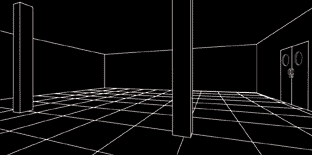|
|
|||||||||
|
|
||
Venue : Leeds City Art Gallery Foyer Dates : from 27th September Times : 10am - 5pm (except Wed until 8pm and Sunday 1.00 - 5.00pm)  A multi-screen animation in the foyer of Leeds City Gallery will launch a virtual representation of a new space housing a 12 month programme of end-to-end artist residencies beginning in November with William Rose. Screenlab is intended as an experimental halfway point between studio and gallery for testing new artistic work applying emerging video projection and playback technologies, motion sensors and virtual environments. Occupying a 50 x 40ft blacked-out room in the gallery Screenlab will foster a unique environment for the development of non-conventional moving image work using leading edge technology normally unavailable to artists. The proposed technical and theoretical support is rarely brought together in a gallery context and in light of this, Screenlab aims to balance an understanding of new imaging technologies with a critical awareness of contemporary art practice. The programme will research sophisticated combinations of digital presentation technology in parallel with the development of the artists' working practice and concerns. The residencies form an important component of Lumen's artistic programme, underpinning its production of Evolution and informing its development of artists commissions utilising new presentation technology. Working in partnership with industry, higher education and artists the programme reflects Lumen's commitment to working in between traditional cultural and economic sectors and creating high quality opportunities for artists. Screenlab is supported by Sanyo, McMillan UK, Stage One, Coldflame Design, The Media Centre, Leeds Metropolitan University (MA/MSC Creative Technology) and Huddersfield University. William Rose November/December William is interested in the use of digital high definition moving image technologies in particular their ability to create expanded moving images which display narrative scenes within their wider, peripheral, context. His working practice often involves discarding the tools that traditionally shape film and cinema such as editing, camera movement and temporal manipulation. What is left is the necessity for the audience to explore the spatial topography of a projection and the space in which it is projected and to search for small intonations in the posture of a single moving image. As a result of this static frame (where the cameras point of view is fixed) his ideas assume an almost photographic quality, not dissimilar to the theatrical proscenium of a stage. Although experimenting with the capabilities of combined high-end technologies William's aim is to prevent production techniques from becoming the focus of his working method and it's presentation to an audience. To this end the technologies are used as a body through which to animate and express ideas. |
| Home|Introduction|2001 Programme|Commissions|Links|Sponsors|Contact |